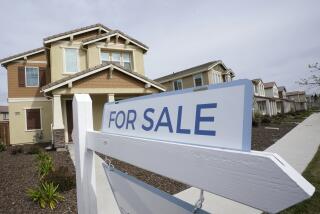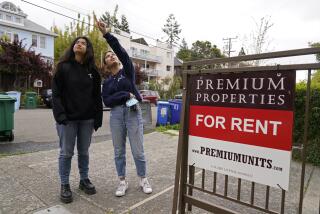Job-creation plan largely ignores housing woes
Reporting from Washington — President Obama’s new jobs-creation plan all but ignores what many economists see as the single biggest problem in the stalling economy: the continuing depression in the housing market.
Home sales, prices and construction have been bad and have been getting worse for so long that Washington and many Americans have grown numb to the problem.
But dig below the surface and housing turns out to be a root cause of many of the other problems that are getting more attention — including the high level of unemployment that Obama focused on in his speech Thursday to Congress.
“That’s probably the biggest missing ingredient here,” economist Mark Zandi said after reviewing Obama’s proposed $447-billion package of tax cuts and infrastructure spending.
More than four years after the sector’s initial collapse, housing has become the economy’s silent killer.
With about one-fourth of all houses in the United States in foreclosure or still underwater — their mortgagesexceeding their market price — millions of Americans face such severe financial problems that they cannot begin to resume their normal roles as consumers, move to new jobs or finance their small businesses.
Many have little prospect of regaining their lost financial security. The housing bust wiped out more than half the $13.5 trillion that homeowners had in equity in early 2006, according to Federal Reserve data.
In addition, the near-halt to construction of new housing has left several million once well-paid workers — many of them with advanced skills and years of experience — either unemployed or just getting by with lower-wage part-time work.
Like the troubled homeowners, most of these workers face long odds against recovering their old middle-class lives unless the industry revives.
As for financial institutions, billions of dollars in bad mortgages have become an albatross that undermines lenders’ basic soundness and discourages new lending for almost any purpose. Weighed down by steep losses in its home-lending unit, Bank of America is preparing to cut 40,000 or more jobs nationwide.
The direct and indirect ties between housing and businesses of almost all kinds are a big reason for the overall lack of economic growth and high unemployment. For makers of building materials, producers of furniture and kitchen appliances and even for grass seed suppliers, the ongoing devastation of the housing market means they also have little reason to invest in expanding operations or hiring new workers.
Coming out of the deep recession of the early 1980s, new-home construction roared back to life — propelling the economy forward and creating 9% of the new jobs in the first year of recovery. This time around, construction accounted for 93% of the net decline in employment.
“Housing — it’s not the American dream, it’s the nightmare,” says Karl E. Case, co-founder of the Case-Shiller home-price index. The latest reading of the index, which calculates price changes for the U.S., fell 4.5% in June year-over-year and is down 32% from five years earlier.
Some economists and political leaders argue that Americans over-invested in housing and should learn to live with lower levels of homeownership.
But regardless of the merits of this point of view, the nation has committed itself to housing as a major driver of the economy over many decades. Reversing that commitment also would take decades and could inflict damage on individuals and the nation that could last a generation or more.
It wasn’t supposed to be like this.
Severe as the housing collapse was, basic economics said that forces were supposed to kick in that would start clearing away the wreckage and begin the process of recovery. The plunge in home prices, combined with historically low mortgage rates, was supposed to pump up sales.
Yet the housing problem shows very few signs of curing itself. Nor has the broader economy grown despite the real estate slump, as some economists and policymakers had hoped.
The health of the housing market is a key element in determining the confidence and spending of consumers, more so than stock prices, because homes are more broadly held by the public. Celia Chen, a housing expert at Moody’s Analytics, estimates the economy has lost $360 billion in consumer spending since the recession — the equivalent of a year’s worth of new-car sales in the U.S.
So it came as a bit of a surprise to many that Obama, in unveiling his jobs-creation package, said little more on the housing issue than that he would help “responsible homeowners” refinance their mortgages.
The plan offers no new measures to give relief to several million borrowers in foreclosure or seriously behind on their loans. And there was no mention of such ideas, backed by some economists and community groups, to convert empty homes into rentals or offer principal reductions on a broader scale.
Obama’s reluctance may reflect concerns about the prospects for a political donnybrook and potentially thorny issues over helping borrowers who got in over their heads during the housing bubble. And the White House may be betting that if it can speed up hiring and growth in the broader economy through its plan, then housing will come along.
That “was the original hope of the economic team” with the $787-billion Recovery Act stimulus launched in early 2009, said Robert Shapiro, a Washington consultant and economic advisor in the Clinton administration.
Shapiro, however, has advocated a government loan program to help clear the pipeline of foreclosures and the broader so-called shadow inventory that are dragging down home prices.
“We bailed out banks,” he said. “This is bailing out homeowners.”
So far, Washington’s record of dealing with troubled mortgages is not encouraging. The government’s main refinancing program has helped about 838,000 borrowers, much less than expected given the estimated 4 million homeowners who are still eligible. Its loan-modification program for distressed borrowers has proved even more disappointing.
As for the private sector, the legal and economic mechanisms that are supposed to force a solution — such as foreclosures and renegotiated deals — also have been largely ineffective.
“The big, big question is, how much inventory are banks sitting on?” said Michael Bates, a broker at 360 Realty in Beverly Hills who specializes in distressed properties. “I’m working with one lender that has 10 listings, but only three are active. The [other] seven are being prepared, but they won’t give me the green light” to show them. Bates doesn’t know why, and the lender won’t say.
The system seems stuck, allowing the pain to continue and the damage to spread.
In southeast Michigan, the auto industry has come back. But the value of Larry Nutson’s home hasn’t.
Nutson figures he owes as much as $250,000 more on his mortgage than his 3,750-square-foot home is currently worth. He has spent months trying to persuade his lender to lower his interest rate of 6.625% to something closer to the prevailing rate of about 4.5%. His bank hasn’t budged.
Nutson is semi-retired and his wife is working full time. They are meeting monthly payments, but their predicament has clouded their future. If they could reduce their home payments or sell the house outright, he said, it would give the couple more cash for spending and even free them up to make a permanent move.
“Who knows where we’ll be, quite frankly,” he said.
Richard K. Green, director of the USC Lusk Center for Real Estate, figures that “the only way we get out from under as a country is if people have equity again.”
More financing will help, Green said. If that extra cash from a lower rate is used to pay down principal, a homeowner with a 4.5% rate on a mortgage that’s 20% higher than the home’s current value could get above water in less than five years, Green said, compared with 10 years for someone with the same loan at 6%.
Eventually, he and other experts said, the housing market is likely to return to more balanced patterns, if for no other reason than the natural growth of families and rising rents that will make owning more attractive. But that still may be a long time away.
“I think without [government] intervention,” Green said, “we’re going to be stuck in this situation.”
More to Read
Inside the business of entertainment
The Wide Shot brings you news, analysis and insights on everything from streaming wars to production — and what it all means for the future.
You may occasionally receive promotional content from the Los Angeles Times.











